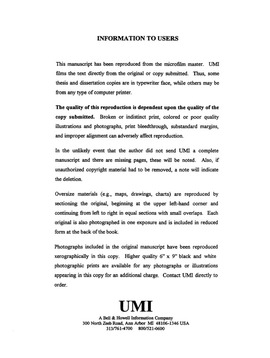| dc.contributor.advisor | Schnell, Gary D., | en_US |
| dc.contributor.author | Leimgruber, Peter. | en_US |
| dc.date.accessioned | 2013-08-16T12:30:25Z | |
| dc.date.available | 2013-08-16T12:30:25Z | |
| dc.date.issued | 1998 | en_US |
| dc.identifier.uri | https://hdl.handle.net/11244/5756 | |
| dc.description.abstract | Forests in the Appalachian Mountains have been severely affected by logging in the past and little old-growth is left. The remaining forests form a heterogeneous mosaic of different forest successions. A concern for conservation is how additional logging will alter the mosaic and its fauna. I studied the effects of logging on the landscape mosaic and how changes in the landscape structure influence small mammals and birds in the George Washington National Forest, Virginia. My dissertation also included research on how to improve techniques for landscape ecological studies, such as roadside monitoring of birds and mapping of forest resources using remote sensing and Geographic Information Systems (GIS). | en_US |
| dc.description.abstract | Using GIS, I determined how logging affected small mammals and birds at the landscape scale. I divided the landscape into three zones (zone 1, inside logged areas; zone 2, 20--400 m from logged areas; zone 3, 1000--1500 m from logged areas). Logging changed species presence and richness more drastically in close proximity of cuts than on the landscape and influenced birds more strongly than mammals. In the cuts, edge-adapted birds, such as the indigo bunting (Passerina cyanea), replaced forest interior species, such as the Acadian flycatcher (Empidonax virescens). Most differences in presence and richness of small mammals were not due to logging. For five species, I found landscape models that predicted changes in species presence based on changes in landscape structure, mainly Shannon diversity and area of deciduous forest. | en_US |
| dc.description.abstract | Because of the scale dependency of landscape-ecological relationships, I investigated how landscape structure in the forest mosaic changes with increasing scales. I determined threshold scales at which structure changed markedly. After establishing a baseline, I examined how logging affected the intensity and location of such thresholds. I found thresholds in landscape structure exist at 400-, 500-, and 800-m intervals from the outer edge of the cut. While logging did not change threshold location and intensity for global landscape indices, such as dominance and contagion, thresholds for focal indices, such as mean patch size and percent cover for early-successional forest, changed markedly. | en_US |
| dc.format.extent | xvi, 181 leaves : | en_US |
| dc.subject | Landscape ecology Appalachian Mountains. | en_US |
| dc.subject | Geographic information systems. | en_US |
| dc.subject | Forest ecology Appalachian Mountains. | en_US |
| dc.subject | Biology, Zoology. | en_US |
| dc.subject | Remote Sensing. | en_US |
| dc.subject | Songbirds Habitat Appalachian. | en_US |
| dc.subject | Agriculture, Forestry and Wildlife. | en_US |
| dc.subject | Biology, Ecology. | en_US |
| dc.title | Landscape structure in a managed forest mosaic of the Southern Appalachian Mountains and its influence on songbirds and small mammals. | en_US |
| dc.type | Thesis | en_US |
| dc.thesis.degree | Ph.D. | en_US |
| dc.thesis.degreeDiscipline | Department of Biology | en_US |
| dc.note | Source: Dissertation Abstracts International, Volume: 59-12, Section: B, page: 6167. | en_US |
| dc.note | Adviser: Gary D. Schnell. | en_US |
| ou.identifier | (UMI)AAI9914409 | en_US |
| ou.group | College of Arts and Sciences::Department of Biology | |
